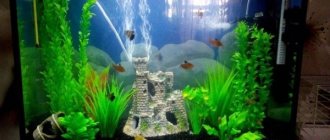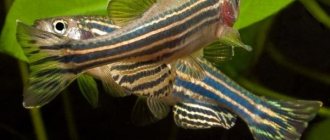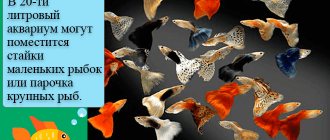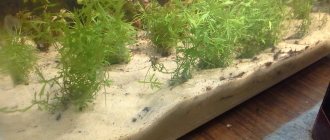Soil is an important component of an aquarium. Plants are planted in it, and nitrifying bacteria participating in the nitrogen cycle live in it. Therefore, inexperienced aquarists often ask questions about which soil is better, how much it should be poured, and others.
The choice of substrate should be based on the needs of the inhabitants and the intended plants of the aquarium. For example, loach fish require fine, rounded soil, as they like to burrow in it. Most plants grow well in natural soil with a fraction of 3-5 mm.
Pet stores sell a large amount of different soil, which can be divided into three groups: natural, artificial and soil.
Natural substrate is gravel, quartzite, sand, crushed rocks (shell rock, dolomite, granite, marble, basalt, pebbles, limestone and others). That is, this is what lies on the banks and bottom of lakes and rivers. In order for such soil to attract the attention of buyers, it is painted in different colors. It can be rounded or unrounded.
Photo: gray - gravel, pink - quartzite, white - quartz sand, black - basalt
to make artificial soil . Such a substrate can change color and glow, and poorly painted pebbles can tint the water. It is used only as decoration.
Color: dark blue, yellow, mixtures of different colors
Specialized soils include soil (active substrate). It contains many nutrients that are necessary for the development of aquarium plants. Such a substrate can change the hydrochemical composition of the water in the aquarium, and is therefore recommended only for experienced aquarists. Used only in herbal medicine, it promotes faster plant growth.
In the photo there is a layer of nutrient gurn
When choosing soil, pay attention to its size, ability to change the hydrochemical composition of water and, of course, color.
Soil particle size
The soil fraction is selected based on the planned inhabitants of the aquarium and plants. The most important thing is that the substrate is porous and metabolic processes can take place in it. For example, fine sand tends to cake, which leads to rotting of the roots. Due to poor water movement, the shallow substrate begins to sour over time. Hydrogen sulfide bubbles appear in it, which is bad for the health of the fish. Now let's look at the dimensions of the soil in more detail.
Sand up to 0.5 mm in size is used only for decorating aquariums. If you put a thick layer, it will begin to cake and sour. Plants in such a substrate do not take root well, and the roots begin to rot over time. This fraction is suitable for small bottom-dwelling fish. Large fish can lift particles of soil upward, which will facilitate their entry into the filter. Granular soil can be used for planting plants. It does not sour or silt. It can be mixed with coarse soil.
Soil measuring 1-2 mm is suitable for keeping many small and medium-sized fish species, especially bottom-dwelling fish. Plants can be planted in such a substrate. But keep in mind that the small size of the soil can lead to acidification. Therefore, a thick layer should not be poured. In large-volume aquariums, it is advisable to mix this fraction with a larger one and only after that lay the required layer. A thin layer of substrate is placed near the front glass. Soil with a fraction of 1-2 mm is not suitable for keeping large fish.
Soil with a fraction of 3-5 mm is used for keeping almost all types of fish. Plants grow well in it, silting occurs slowly. In an aquarium with such a substrate, you can install a bottom filter. This type of soil is not suitable for fish that burrow into the ground.
Soil with a fraction of more than 5 mm is not used for growing plants. By mixing such a fraction with a smaller one, rooting will become possible. Coarse soil is placed in an aquarium with fish swimming in the water column and near the surface.
Nutritious
The nutritional value of the soil plays an important role. Since most plants receive nutrients from the nutrient substrate. To enrich the soil, you can add special fertilizer tablets or substrates to it.
Tetra ActiveSubstrate (Tetra)
This substrate is intended for plants and is natural. It consists of granules that provide a suitable environment for the algae root system. Due to porosity, a large number of beneficial bacteria settle in the soil. Its main advantages include the fact that it:
- promotes active growth of beneficial bacteria;
- prevents water pollution with organic substances;
- reduces the load on the filter;
- prevents root rotting;
- provides essential nutrients to algae roots;
- improves water circulation;
- has an attractive appearance.
The average cost of goods in Moscow and St. Petersburg is 550 rubles. per pack 3 liters.
JBL AquaBasis
This soil is used to provide all living plants with nutrients. It does not reduce water hardness levels and does not release toxins. The porosity of the soil promotes the growth of beneficial bacteria on the surface. Soil producer – Germany. Its advantages include:
- good growth of the plant root system;
- excellent filtration on the surface;
- does not harm the antennae of fish crawling along the bottom.
There are no cons found for this product.
The price in Moscow and St. Petersburg for a 1.5 liter package is 405 rubles.
Fluval
Its advantages include:
- providing a safe environment for underwater inhabitants;
- stimulation of plant growth;
- neutralization of acidity levels.
They have a light and porous structure. There are no lumps in them and they create a favorable environment for bottom fish and shrimp. fluval soil is enriched with useful microelements and minerals.
The average cost in Moscow and St. Petersburg is 580 - 1500 rubles per 2 kg. Soil fraction – 1.5-2.5 mm.
Ground color
It is best to use soil for aquariums in colors that are found in nature. If the substrate is light, the fish may lose their color, that is, become lighter. This is how they adapt to their environment.
As for the popular colored primer, it is better not to use it at all. If you like it, then use it in small quantities for decoration. When choosing it, make sure that the paint does not fall off, pay attention to the manufacturer and the smell. If a sharp, unpleasant odor is heard from the bag, then such soil can release toxic substances into the water, and the aquarium will become unsuitable for fish.
Aquarium soil calculator
When calculating the required amount of soil for an aquarium in kilograms, difficulties may arise, since each type of soil has a different density and weight. It is most convenient to calculate its quantity in volume.
The required amount of soil is calculated using the following formula:
m(kg) = a*b*h
where m is the mass of the soil, a and b are the length and width of the proposed aquarium (in cm), h is the height of the soil layer (in cm). All calculations are determined in volume (liters).
Eg:
length 1000 – mm
width 600 mm
ground height 70 mm
10*6*0.7 = 42 dm2 = 42 liters
If a manufacturer sells soil in kilograms, then the resulting volume (in liters) is multiplied by its density. So, if 1 liter of soil is equal to 1.4 kg, then this is its density, which is measured in l/kg. Accordingly, the resulting volume in liters must be multiplied by another 1.4. The result is:
36*1.4=50.4 kg – soil weight
If you plan to make a large ground slope, you will have to accurately determine the midpoint of this slope. It will be at the expected height. To calculate the exact amount of soil, you should start from it.
Examples of density calculations for different soils (in kg):
- quartz sand (density 1.4 kg/l);
- marble chips (density 2.7 kg/l);
- nutrient soil (density 1.1-1.2 kg/l);
- proppant (density 1.8 kg/l).
The impact of the substrate on the hydrochemical composition of water
Some types of soil can change the hydrochemical composition of water. Marble chips increase dGH. Anthracite-based soils are used for acidification. Neutral substrates include sand, granite, quartz, basalt, and artificial soil. The soil softens and acidifies the aquarium water, which promotes rapid plant growth.
Based on the characteristics of the soil, fish are selected. For example, marble chips would be appropriate in aquariums with cichlids from Lake Malawi and Tanganyika. But for keeping gouramis, tetras and other fish, it is better to use a neutral substrate.
Influence of soil on biological balance
A home artificial pond is a closed system, each link of which is interconnected with the other. In other words, the condition of the soil greatly affects the flora and fauna. The correct substrate in an aquarium is important as it has a huge impact on the balance, especially if there are many plants planted in the tank. If the soil in the tank does not meet the requirements of the flora, then the underwater flowers will not grow and produce oxygen, without which the pet faces oxygen starvation.
Beginning inexperienced aquarists often make the mistake of trying to feed the soil in the tank with different substances: clay, coal or peat. Such an explosive mixture will definitely not benefit pets and plants, but, on the contrary, will harm the inhabitants of the aquarium. However, it is fair to note that the listed substances can be used in small parts, feeding only the planting area, and some materials affect water parameters, which is used by experienced aquarists:
- Adding peat will soften and acidify the liquid.
- Crushed marble will raise the hardness.
Aquarium soil
Aquarium soil or soil is a special soil that contains nutrients. Thanks to the soil, the water becomes soft and slightly acidic. This environment is suitable for plant growth and the existence of many aquatic organisms. The fact is that at a pH below 7, plants absorb micro and macroelements well. Nitrifying bacteria necessary to maintain biological balance develop well in the soil.
Manufacturers make soil from clay materials, materials of volcanic origin, and compressed earth. During the manufacturing process, the material is given a granular form. Depending on the purpose, the substrate is enriched with fertilizers, activated carbon and other substances are added.
The soil is lighter than gravel and has uniform particle sizes. Thanks to this, the plants take root quickly. It is used in aquascapes.
How to choose?
The average cost of aquarium components will be indicated for Moscow and St. Petersburg.
The choice of both soil and substrate depends on what inhabitants will be in the aquarium, what plants will be planted there, as well as on the dimensions of the vessel itself.
Which manufacturer makes the best soil for plants?
The most popular now are granular components, the production of which is carried out by a considerable number of companies. Let's name the best-selling manufacturers.
Aqua Soil
Mixtures from this company help reduce the acidity level of water, as well as its hardness. However, it can only be used for freshwater aquariums. The average price of the mixture is 2500 rubles.
Experts recommend refraining from using such soils in containers where fish live and dig up the soil layer.
Dennerle DeponitMix Professional
This complex includes peat, clay, quartz sand, granules that provide biofiltration, as well as the soil itself with nutritious minerals and iron. You can purchase the complex for 1200 rubles.
The Dennerle DeponitMix Professional mixture helps strengthen the root system and also grow thick greenery. The fact that there are no phosphates and nitrates in the complex saves the aquarium from algae thickets.
Plant Complete Substrate Concentrate
This is already completely ready-to-use soil. It includes the following components: natural sand, minerals, humic acids and peat.
The soil is laid out in the aquarium in a layer whose thickness is 2 centimeters. In those areas where you plan to plant the plant, the layer can be slightly increased. To achieve maximum effect, the soil can be mixed with fine gravel. The cost of soil ranges from 1200-1500 rubles.
- Dennerle Nutri Basis 6 in 1 for plants - costs about 1000 rubles for 2.4 kg;
- Tetra Plant CompleteSubstrate - 1100 rubles per 3 kg;
- ADA Power Sand Special-S - costs much more: 2000 rubles for two liters.
I added a specialized substrate to the soil. Can I siphon it like a regular one?
If you use a specialized substrate, the siphon can significantly thin it out. At first, at least until significant siltation occurs, it is better to avoid using a siphon.
If they make a substrate, then they plant a lot of plants. And if you plant a lot of plants, then, in general, there is no need to siphon. And if it so happens that you need to siphon, then only the top layer of soil will siphon (and with a substrate it should be at least 3-4 cm).
Well, it should be clarified that the substrate cannot be used with heavily digging animals, such as cichlids or crustaceans - if they get to the bottom of it, there will be a rush in the aquarium.
Types of soil according to different criteria
By origin:
- Natural (aquarium sand, lava, tuff, quartz soil, sea and river pebbles);
- Processed (vermiculite, baked clay);
- Artificial (glass soil, plastic balls).
Based on their effect on water, soils are divided into:
- Neutral, which do not affect water and do not help plants;
- Carbonate, with a high calcium content (shell rock, coral chips);
- With impurities that may be harmful to fish (for example, colored substrate, garden soil, stones with weak radioactivity).
The size of the soil is:
- Dust-like - fraction up to 1 mm, unsuitable for most aquariums, as it is difficult to clean;
- Fine-grained - fraction 1-3 mm, chosen when it is planned to grow plants with a weak root system in the tank;
- Medium grain – 4-6 mm, suitable for flora with a good root system;
- Coarse-grained - more than 7 mm, rarely used, as it does not create a sufficient “biological cushion” and is not suitable for the nitrogen cycle.
The nitrogen cycle is a chain of chemical reactions in which ammonia from fish waste passes through nitrite ions into nitrates. Proper nitrification is extremely important for any aquarium fish.
Commercial mixtures are specialized. For example, denerle is a soil that is excellent for plants. Neutral safe soil Tetra is designed for comfortable keeping of fish.
Starting and maintaining an aquarium
The purchased tank is washed with water. Do the same with soil and decorations. A clean aquarium is placed in a prepared place, a background is glued to the back wall and the substrate is poured inside the container. Next, equipment and decorations are placed. After this, pour water and turn on the filter and heater. Plants are planted 1-2 weeks after starting; simultaneously with planting greenery, turn on the lighting. Hydrobionts are introduced no earlier than 2 weeks after starting the aquarium.
Water changes are performed by 30-40% every 2 weeks. The soil is cleaned with a siphon once a week. The internal filter is washed weekly, and the external filter once every 3-4 months. As they become dirty, remove deposits from glass and decorations.
How to properly care for the soil
The properties of the filler are lost if proper care is not carried out. Keeping and caring for aquarium fish includes weekly water changes and regular cleaning of the soil with a siphon. The siphon removes large dirt, waste and food residues, but does not disturb the biological balance. You need to clean the soil carefully, without actively stirring it, but simply pulling out excess dirt from the soil.
What is strictly forbidden to use as a primer?
In order to save money, some aquarium owners form the soil from those components that are not suitable for these purposes, endangering all living things. Never use:
- Expanded clay cat litter - when in contact with water, it can cause cloudiness and a change in acidity towards alkalization. They contain flavorings and a lot of inclusions that are dangerous for fish.
- Marble and shell rock - upon prolonged contact with water, release calcium carbonate, which makes the water hard and unsuitable for some species of fish.
- Fine glass filler – there is no porosity necessary for the development of beneficial microflora. Suitable as a bulk decorative element of a separate part of the aquarium, but not for full-fledged soil.
- Garden soil and substrates for indoor plants containing peat and mineral inclusions - upon contact with water, an oxidation process occurs, which causes rotting. Such microflora is destructive for most fish.
To check a commercial aquarium filler for the presence of high calcium carbonate content, you need to drop a few drops of vinegar onto its dry surface and observe the result. If small bubbles appear, it means the soil will change the composition of the water to the alkaline side.
Acid helps neutralize high concentrations of alkali. To do this, the soil is laid out in a flat container in the thinnest layer possible and filled with vinegar. Let stand for several hours, then rinse well with cold water.
Commercial Nutrient Soils and Substrates: A Brief Overview
Such branded aquarium products used to come in the form of soil to which various substances were added. Soils balanced in this way were simply poured onto the bottom of the “can.”
From the editor: Styphodon gobies
Currently, granular bottom substrates have become most popular, varieties of which are produced by many companies: German Dennerle, JBL, Tetra, Polish Aquael and many others.
Aqua Soil. An example of soil is Aqua Soil - Africana, Amazonia, Malaya. This mixture helps reduce the pH level and hardness of aquarium water. Designed exclusively for freshwater aquariums.
Experts do not recommend using this soil when keeping fish that dig in the soil.
Dennerle DeponitMix Professional soil mixture consists of selected natural peat, high quality natural clay, soil with nutrient minerals and iron, quartz sand and granules to provide biological filtration and remove nitrites from water. It helps strengthen the root system of vegetation and healthy foliage. The absence of phosphates and nitrates in the mixture eliminates the formation of green algae.
JBL AquaBasis plus is widely used and includes:
- natural peat acting as humus;
- selected clay in the form of granules;
- mineral supplements that also contain large amounts of iron;
- porous granules for the formation of colonies of denitrifying bacteria.
The mixture is spread evenly along the bottom of the aquarium (layer thickness 2–3 cm), and treated fine gravel is carefully poured on top. In this case, a commercial mixture, the service life of which is 3 years, plays the role of a substrate
Plant Complete Substrate Concentrate from Tetra is a ready-to-use primer. It contains: a mixture of various types of natural sand, minerals, humic acids, which have ion-exchange, sorption and biologically active qualities, as well as peat.
The soil is poured onto the bottom of the new aquarium in a layer 2 cm thick. In places where aquatic plants are planned to be planted, the layer can be made a little thicker. It is possible to use either the finished product or mix it with fine-grained rolled gravel. This concentrate prevents the appearance of algae, strengthens roots, and promotes normal development of stems and leaves.
The range of nutrient soil mixtures is very wide, and to make the right choice, you should carefully read their composition, as well as carefully read the instructions for use.
Nutrient soils are designed to ensure the good development of aquarium plants, but this is not their only function. Modern commercial ready-mixes significantly improve water quality. And this is the most important factor in the good health of ornamental fish.
Video tip on how to make a nutrient substrate for aquarium plants:
Decorating a 60-liter aquarium
The interior design of a 60-liter aquarium is an exciting event that will allow the owner to make his dreams come true and create a cozy and colorful little world with his own pets. However, in pursuit of beauty, it is important to remember the requirements of the fish for which the pond is being built, equipment and other important elements - for example, choosing a cabinet for a 60-liter aquarium that can support the weight of the container.
To avoid mistakes in organizing a home aquarium, you should take the advice of experienced colleagues.
Style
An aquarium made in the same style always looks more attractive than a pond with chaotically arranged elements. A 60-liter container can be decorated in one of the existing styles, or you can come up with your own. Among the popular styles for a 60 l aquarium, the following are suitable:
- Dutch - involves the creation of a herbal pond with an abundant amount of green plants.
- Biotope - a container in this style imitates a certain natural body of water: a lake, river or stream.
- Thematic style will fit perfectly into the interior of a children's room or playroom. In this case, the container is designed according to the plot of a cartoon, fairy tale or book.
A striking example is the tank, designed according to the plot of the fairy tale “The Little Mermaid”.
Background
Decorating an aquarium involves not only placing decorations and stocking fish, but also choosing the right decorative background for the tank. This can be either a self-adhesive film or hand-painted back wall with paints - it all depends on the personal preferences and skills of the owner. However, without a decorative background, a cubic pond will look unfinished, and the bright colors of the fish will appear paler. To make the overall appearance of the aquarium look harmonious and natural, experienced aquarists recommend choosing an aquarium background in the same style as the bedside table for the tank.











